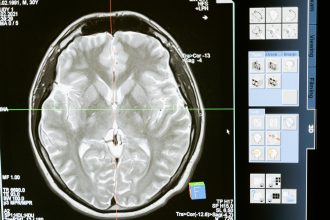Among the many kinds of traumatic brain injury, few are as devastating — or as complex — as diffuse axonal injury (DAI). Unlike visible bleeding or localized bruising, DAI occurs deep within the brain’s wiring. It stretches and tears the nerve fibers that carry messages between brain regions, often leading to widespread dysfunction and, in many cases, prolonged unconsciousness or coma.
- What Is Diffuse Axonal Injury?
- How Diffuse Axonal Injury Happens
- Severity Levels of DAI
- Symptoms of Diffuse Axonal Injury
- Diagnosis: Imaging and Clinical Assessment
- Treatment: Stabilization and Long-Term Rehabilitation
- Prognosis and Recovery
- Long-Term Effects and Complications
- Preventing Diffuse Axonal Injury
- The Takeaway
Understanding how this injury happens, why it’s so serious, and what recovery may look like helps families and clinicians prepare for the long road of rehabilitation and care that follows.
What Is Diffuse Axonal Injury?
Diffuse axonal injury is a widespread injury to the brain’s white matter, the network of axons that connect nerve cells. Axons act as communication cables, transmitting signals between the brain’s gray matter regions and the spinal cord. When these fibers are stretched or torn, information flow becomes disrupted across multiple areas of the brain.
This “diffuse” nature means damage occurs in many places at once, rather than in a single, localized spot. It’s one of the hallmark injuries seen in high-speed collisions, severe falls, or violent shaking, and it often results in loss of consciousness at the moment of impact.
How Diffuse Axonal Injury Happens
The brain is soft and suspended in fluid inside the skull. During sudden acceleration or deceleration — such as when a car stops abruptly or the head is violently shaken — the brain shifts and rotates within the skull.
This movement causes shearing forces that stretch the long axons of nerve cells. These forces are especially harmful during rotational motion, when the brain’s upper and lower regions move at different speeds. The tearing primarily affects:
- The corpus callosum, which connects the brain’s hemispheres
- The brainstem, which controls consciousness and basic life functions
- The frontal and temporal lobes, responsible for decision-making, memory, and emotion
Even microscopic tears can interrupt signal transmission, leading to loss of consciousness or prolonged coma.
Severity Levels of DAI
Diffuse axonal injury can range from mild to severe:
- Mild DAI: May cause brief loss of consciousness or confusion, sometimes overlapping with concussion symptoms.
- Moderate DAI: Leads to longer unconsciousness (hours to days) and noticeable cognitive, emotional, or physical deficits upon waking.
- Severe DAI: Often results in coma lasting more than six hours and widespread brain dysfunction visible on imaging scans.
The outcome depends on how many axons are damaged and where the injury occurs. Even mild cases can cause lasting problems with attention, mood, and coordination.
Symptoms of Diffuse Axonal Injury
Because DAI affects multiple brain regions, symptoms can be varied and unpredictable. Common signs include:
- Loss of consciousness at the time of injury
- Prolonged coma or vegetative state
- Disorientation or confusion upon waking
- Memory loss and reduced attention span
- Difficulty with speech or understanding language
- Poor coordination or balance
- Emotional instability, irritability, or apathy
- Sleep disturbances and fatigue
In milder cases, individuals may appear awake but struggle with concentration, impulse control, or processing speed.
Diagnosis: Imaging and Clinical Assessment
Diagnosing diffuse axonal injury requires both neuroimaging and careful clinical evaluation.
- CT scans are often the first step in emergency care. They can detect bleeding or swelling but may not reveal the microscopic axonal damage typical of DAI.
- MRI (Magnetic Resonance Imaging), especially using diffusion tensor imaging (DTI), provides more detailed visualization of white matter tracts and subtle lesions.
- Neurological assessments—including Glasgow Coma Scale (GCS) scoring—help determine the level of consciousness and guide prognosis.
A definitive diagnosis often combines imaging results with observation of persistent symptoms and behavioral changes over time.
Treatment: Stabilization and Long-Term Rehabilitation
There is no single cure for diffuse axonal injury. Treatment focuses on stabilizing the patient, minimizing secondary injury, and promoting gradual recovery through multidisciplinary care.
Acute Care
In the initial phase, the medical team works to:
- Maintain oxygen and blood flow to the brain
- Control swelling and intracranial pressure
- Prevent complications such as seizures or infections
Patients with severe DAI may spend days or weeks in an intensive care unit, often requiring mechanical ventilation and careful neurological monitoring.
Rehabilitation Phase
Once stabilized, recovery shifts to long-term rehabilitation. This phase often includes:
- Physical therapy: To improve strength, mobility, and coordination
- Occupational therapy: To rebuild daily living and self-care skills
- Speech and language therapy: To address communication and swallowing difficulties
- Cognitive rehabilitation: To retrain attention, memory, and problem-solving
- Neuropsychological care: To manage mood, behavior, and emotional regulation
Family involvement is crucial. Structured routines, consistent communication, and emotional support can help the brain relearn and adapt.
Prognosis and Recovery
Outcomes vary widely. Some individuals regain significant function over months or years, while others remain in a minimally conscious or vegetative state.
Prognosis depends on:
- The severity and location of axonal damage
- Age and overall health of the patient
- Speed of medical intervention and access to rehabilitation
While complete recovery from severe DAI is rare, gradual improvements in awareness, communication, and movement are possible. Early and sustained therapy gives the brain the best chance to reorganize through neuroplasticity.
Long-Term Effects and Complications
Even after recovery, many survivors of diffuse axonal injury face persistent challenges:
- Cognitive impairments such as slowed thinking or difficulty multitasking
- Emotional instability or depression
- Fatigue and sleep disruption
- Chronic headaches or dizziness
- Social and vocational difficulties
These issues can strain relationships and limit independence. Continued therapy, counseling, and adaptive strategies remain important long after initial recovery.
Preventing Diffuse Axonal Injury
Because DAI usually results from sudden acceleration or deceleration, prevention efforts focus on reducing these forces in daily life:
- Always wear seat belts and use appropriate car seats for children.
- Wear helmets during sports, cycling, and motorcycling.
- Reduce fall risks in the home and workplace.
- Promote safe driving and avoid distractions or speeding.
For athletes and military personnel, improved helmet design, impact monitoring, and rest after concussion all play vital roles in prevention.
The Takeaway
Diffuse axonal injury is one of the most serious forms of brain trauma, often invisible on the surface yet life-altering in its effects. It reminds us how delicate and interconnected the brain truly is — and why prevention, early care, and sustained rehabilitation matter so deeply.
Behind every MRI image is a person relearning how to move, think, or simply be present again. With understanding and compassion, recovery becomes not just medical but human.







